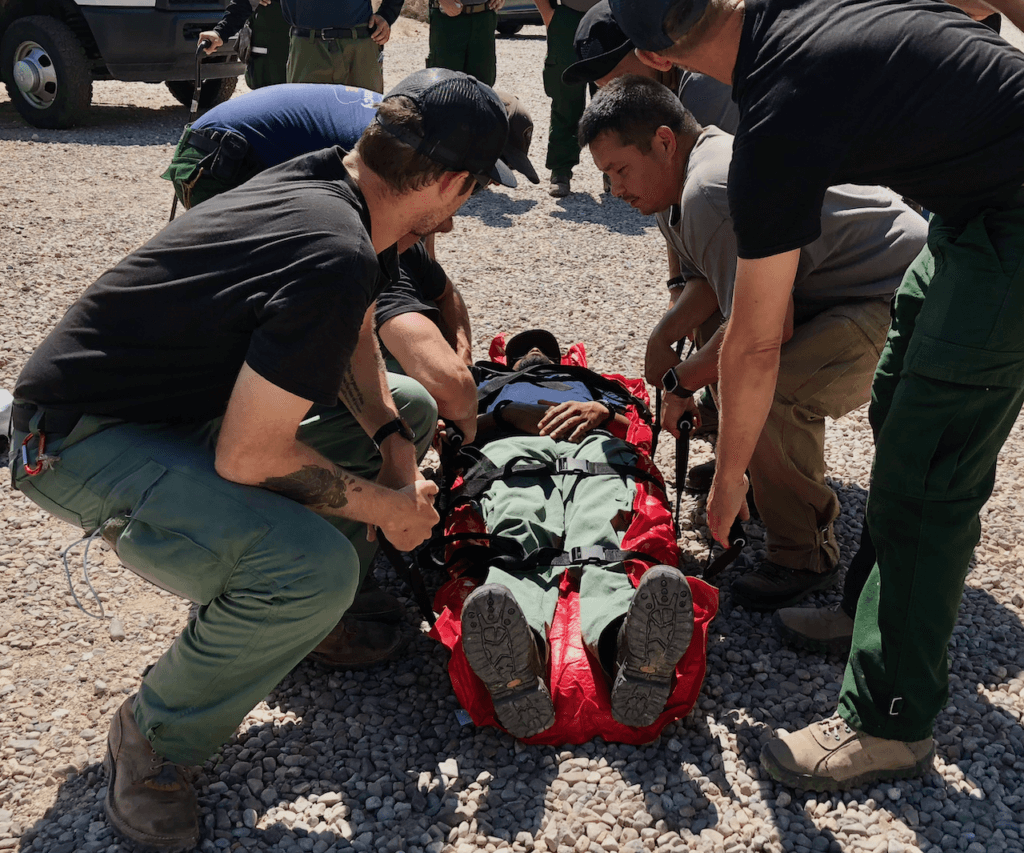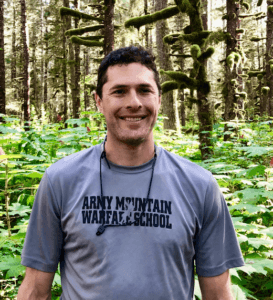Eli Schned, an emergency room doctor and former firefighter, shares the lessons learned from a prototype course that focuses on the medical emergencies faced by firefighters on the fireline. Training and preparing for trauma, injuries and evacuations unique to the fireline should be our standard.
by Eli Schned
The National Wildfire Coordination Group (NWCG) has done a good job of prioritizing safety in wildland fire operations and promoting human life over property. For example, fireline checklists inspired by aviation safety prove their worth every day. Nevertheless, the work remains — and will always be — inherently dangerous. There are simply too many variables in nature to realistically overcome all risk. Consider a smoldering snag: Although an experienced firefighter can read a snag well, the infinite variables that keep the snag standing — soil, wind, slope, etc. — can conspire to bring the snag down suddenly and with deceptively little warning. With tens of millions of snags and tens of thousands of wildland firefighters operating about them, it is statistically certain that a snag will fatefully fall at the wrong time in the wrong direction. In an effort to improve response to the inevitable injuries, we propose a universal Basic Fireline Life Support system that addresses the medical emergencies specific to wildland fire and does not require any prior medical experience. Earlier this year we ran a pilot of this course with several crews in USFS Region 1. We propose that it can be scaled to all at-risk personnel regardless of their medical background
The fire agencies have relied on the National Registry of Emergency Medical Technicians (NREMT) to provide the foundation of their emergency medical response. The NREMT provides excellent standardized training and is integral to the national EMS response. However, the EMT curriculum reflects America’s health burden — elderly with chronic medical diseases. The wilderness self-selects and it is unlikely a wildland firefighter EMT will encounter end-stage chronic obstructive lung disease, uncontrolled diabetes, or congestive heart failure on the fireline. Only a small portion (less than five to ten percent) of a standard 100-hour basic EMT class discusses traumatic injuries. Additionally, there is nothing in the curriculum on decision making for types of evacuation (e.g. ground vs. air). It is a given in the class that the EMT will be part of an ambulance team, obviating this decision point. Major trauma in the young and healthy is a major cause of morbidity in wildland fire. A wildland firefighter who encounters a major trauma in the wilderness faces the challenge of an improvised evacuation with little help from their EMT training in managing the patient.
Similarly, wilderness first responder and wilderness EMT classes provide great exposure to medicine specifically in the wilderness. It certainly helps urban based EMTs and rescuers start to think about how the practice environment often dictates patient management. However, these classes, while shorter than NREMT certifications, will often take a full week or more and are still prohibitively long from the perspective of training all wildland firefighters. And like urban EMT classes, the material is diluted by topics that are less relevant to wildland fire like toxicology (i.e. drugs and medications), pediatrics, obstetrics, geriatrics, diving injuries, and altitude illnesses.

Luckily, wildland firefighters are self-motivated, resourceful, and physically fit. These are all ideal characteristics for remote medical rescue. Virtually all wildland firefighters are facile with radio communication and many have great experience with rotor wing aircraft. With additional focused training, we can give all wildland firefighters the tools they need to successfully care for critical injuries and important wilderness medical emergencies such as anaphylaxis and he at stroke.
In May 2019, we taught a prototype course with several crews in USFS Region 1. We kept it brief, about an hour, and prioritized content that was not overly technical and could be easily taught and retained. The primary focus of the course was recognition and management of major traumatic injuries in a wildland fire specific setting. We began by teaching recognition of subtle signs of a critical injury but without traditional tools like blood pressure measurement, which requires specialized training and is onerous to use in the field and fraught with potential inaccuracies. The course borrowed from the Stop the Bleed curriculum, teaching how to manage life-threatening extremity bleeding. Although these injuries are relatively rare in wildland fire, they are the only field-treatable traumas that require no advanced training or tools to save a life. The remainder of the lecture focused on evacuation by starting a conversation about which patients needs evacuation and what type of method should be used. Not all injuries require evacuation and of the ones that do, not all need rotor wing evacuation. Effective communication and coordination with rescue resources was also emphasized. The course concluded with hands-on practice with the entire crew cycling through a simulated incident that required rapid assessment and recognition of injury, radio dispatch, and immediate evacuation on an appropriate backcountry stretcher.
Repetition in simulation training builds muscle memory and reduces the cognitive burden when encountering an actual major trauma. Just as important is that the training is realistic and adheres to the principle of “no training scars.” Shortcuts in training are pernicious as the same shortcuts invariably rear during the real thing. For instance, it is not acceptable for the trainee to verbalize, “I would then roll the patient.” They actually have to do it or they are likely to skip the same step when they are cognitively overwhelmed in a critical event. The more stressful the training, the more inoculated to stress the rescuer will be when actually faced with a major injury. At the end of our brief course, it was rewarding to see firefighters execute critical skills including single-person rescue on an appropriate backcountry stretcher, treatment, transport, and communication with a simulated dispatcher while recognizing subtle signs of major bleeding.
Fireline medicine training needs to focus on the basics of hemorrhage control, evacuation, and fundamentals of a select group of treatable wilderness emergencies (e.g. anaphylaxis, heat stroke, heart attacks, rhabdomyolysis). The NREMT curriculum falls short of what firefighters need. But the NWCG course catalogue already provides a model for more appropriate training. Basic Fireline Life Support should be integrated into the training of all wildland firefighters. If not as part of the Basic 32 (the core introductory fire training), then as the equivalent of a 200-level S course that could be completed in a day or less. We envision the completion of such a course as a goal for all firefighters, and especially for all interagency hotshot crews (IHCs), smokejumpers, helitack, and anyone at the Squad Boss level or above.
A higher level course (e.g. S-300, 400 level) could provide deeper knowledge for line medics, medical unit leaders, EMTs, or anyone else with an interest in additional medical training. It is time to stop trying to bring the urban ambulance to wildland fire and time to start prioritizing rapid evacuation and lifesaving interventions.

Eli Schned, MD, FAWM, DiMM, EMT-I, is a former US Forest Service hotshot firefighter and smokejumper. He practices Emergency Medicine and currently lives in New Haven, Connecticut. He recently completed a fellowship in Wilderness Medicine at Yale University.
+
FURTHER READING
Alex Viktora. “Medevac: How We Got Here.” Wildland Fire Lessons Learned Center June 13, 2019. https://wildfirelessons.wordpress.com/2019/06/13/medevac-how-we-got-here/.
BIA Wildland Fire First Aid Program. https://www.bia.gov/bia/ots/dfwfm/bwfm/safety/first-aid-project. An example of a fireline focused medical program, launched by the Bureau of Indian Affairs in 2018, that is “… specially designed for wildland firefighters who are non-medical professionals.”
